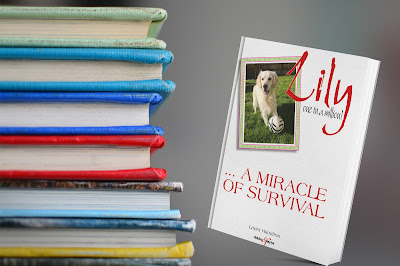Winter is finally coming to an end, and what better way to spring into action than reading about our first release of 2018, Lily: one in a million! ... a miracle of survival!
In case you may have been hibernating since the end of last year, you might not know that author Laura Hamilton has been super excited about the release of her first book, and has been gracious enough to supply all of us here at H&H HQ with delectable home-made treats, such as biscuits and mince pies. But that's not all Laura has been up to, as she and Lily have been busy self-promoting their book locally and beyond!
As it stands, the achievements are quite impressive, and Laura and Lily have plenty more promotional forays planned! Here's what the pair have been up to in the run-up to their book being published ...
That's Solent TV interview
Back in February, Laura and Lily appeared on That's Solent TV, a local station in the Southampton area that covers an array of local news stories. The full interview can be viewed below.
Telephone interview with the States
The television interview proved such a success that Laura was contacted by American website Storytrender to give an interview! The hope is that national newspapers from both sides of the Atlantic will run the story and help spread their message far and wide. You can read the interview in full here.
World Book Day
 It may have been snowing in the run-up to this year's World Book Day, but Laura, Lily, and Lily's mother, Pilot, managed to put in an appearance at a local primary school just before the worst of the storm hit. As well as talking about the book, Laura talked about Pets As Therapy, showing the children the girls' demonstration of basic obedience with hand signals and retrieving.
It may have been snowing in the run-up to this year's World Book Day, but Laura, Lily, and Lily's mother, Pilot, managed to put in an appearance at a local primary school just before the worst of the storm hit. As well as talking about the book, Laura talked about Pets As Therapy, showing the children the girls' demonstration of basic obedience with hand signals and retrieving.
Not only was Laura intent on publicising her own book, she also offered to take along a copy of Worzel says hello! Will you be my friend? to read to the children, which they thoroughly enjoyed!
Magazine coverage aplenty!
If you reside in Hampshire or Wiltshire, Laura and Lily feature in the current edition of View Magazine. Don't worry if you aren't able to pick up a physical copy, as you can digitally view the March edition here.
A little further afield, Laura and her book feature in the current issue of Vic Report, the magazine of both Victoria University and the University of Toronto, in her home country of Canada. The issue is available online for those who wish to take a look at Laura's Canadian mention!
So far, we've received nothing but glowing feedback for this book, with numerous five-star reviews. It's great to hear that Laura's labour of love has been so well received.
"I re-read the book on three occasions, learning something new each time. A very careful description of Lily's problems give the background and shows just how dedicated her owner was in first of all noticing her problems with suckling, then feeding and drinking. Well written and beautifully illustrated ... well worth every penny." – Trevor Turner
"Lily: one in a million is more than a celebration of a life with dogs. It is also a living testament to the endurance of love beyond loss. [This book] is about breeder ethics. It's a new way of seeing interspecies relationships. It's a sharing of transcendent moments of healing and of inspiration. Despite being advised to put Lily down, Laura endured and was richly rewarded." – Geelong Obedience Dog Club
"Lovely, lovely story not only about a stunning dog, but also about the sheer determination of her owner to help her survive when most others would have given up. The book is a story from when the litter are first born and is written step-by-step through the intensive care and steep learning curve on how to look after Lily and for her to live. An amazing paperback to read, which I didn't put down once started! Lovely photos as well." – Dog Training Weekly









